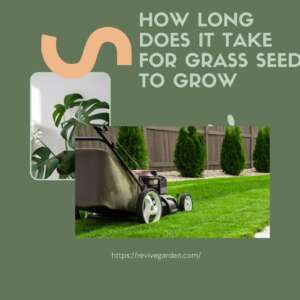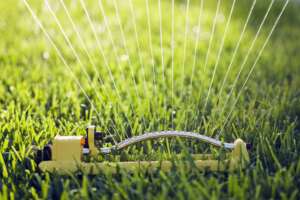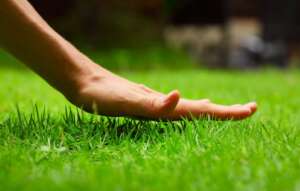Table of Contents
 Grass seed takes approximately two months to germinate and grow, so be prepared to wait a few weeks before seeing any noticeable results. Remember that the length of time it takes for grass to grow will vary depending on the grass seed you purchase and the climate where you live. As we all know, keeping a lawn healthy and looking good is a lot of work. It helps if you take care of several things to achieve this: mowing the lawn regularly, watering it correctly, and fertilizing it when necessary.
Grass seed takes approximately two months to germinate and grow, so be prepared to wait a few weeks before seeing any noticeable results. Remember that the length of time it takes for grass to grow will vary depending on the grass seed you purchase and the climate where you live. As we all know, keeping a lawn healthy and looking good is a lot of work. It helps if you take care of several things to achieve this: mowing the lawn regularly, watering it correctly, and fertilizing it when necessary.
Understanding Grass Seed Germination
Grass seed germination is when a dormant seed sprouts and develops into a young plant. It is a critical stage in the grass growth cycle, marking the beginning of the plant’s life. Understanding the process of germination is key to successfully establishing a healthy and vibrant lawn.
Germination primarily depends on three essential factors: moisture, temperature, and soil conditions. Let’s explore each of these factors in more detail:
Moisture: Adequate moisture is crucial for grass seed germination. When a seed absorbs water, it triggers biochemical reactions within the seed, initiating growth. However, excessive water can lead to rot or mold formation, so striking a balance is important. Keep the soil consistently moist but not overly saturated during the germination period.
Temperature: Different grass seed varieties have specific temperature requirements for optimal germination. Generally, cool-season grasses, such as Kentucky bluegrass and fescue, germinate best at temperatures between 60-75°F (15-24°C). Warm-season grasses, like Bermuda grass and Zoysia grass, prefer temperatures ranging from 75-85°F (24-29°C). It’s essential to consider the appropriate temperature range for the specific grass seed you are using.
Soil Conditions: The condition of the soil directly affects germination success. The soil should be well-prepared, free from debris and weeds, and have good drainage. Loose soil allows the seed to establish root penetration easily. Preparing the soil by tilling, removing rocks and weeds, and adding organic matter or compost is recommended to improve its structure and nutrient content.
In addition to these factors, some grass seed varieties require special treatments to enhance germination. Scarification, which involves scratching or nicking the seed coat, can improve water absorption. Stratification helps break seed dormancy in certain grass species by subjecting seeds to cold temperatures.
During germination, the grass seed absorbs water, swells, and sends out a small root (radicle) and shoot (coleoptile). The root anchors the seedling into the soil while the shoot emerges above the ground. Over time, the seedling develops leaves, which enable photosynthesis and further growth.
It’s important to note that germination times can vary depending on the grass seed type and environmental conditions. Some grass species may sprout in as little as 5-7 days, while others may take up to 2-3 weeks or longer.
Factors Affect in Growth of New Grass
Several factors affect new grass to grow well:
- Soil fertility
- Controlling insects, weeds and diseases
- Watered properly
- Germination time
- Weather
Learn more about how these factors affect the new grass seed to grow well.
Soil Fertility
It is an important factor when trying to grow new grass. The quality of the soil is vital in helping the grass to grow healthily, and there are lots you can do to improve the soil’s fertility. By doing this, you’ll be able to provide your grass with the nutrients it needs to grow successfully.
Controlling Insects, Weeds, and Diseases
As gardeners, one of our main concerns is controlling pests and weeds. If we can manage these problems early on, it’ll make growing fresh vegetables and flowers easier. In this post, we’ll teach you how to control insects, weeds, and diseases so that you can grow new grass.
Watered Properly

Proper watering is essential for healthy grass. Every unique type of grass needs a different amount of water. Some are required once a week, and others require daily. So, it is essential to know the grass type and its requirements.
Germination Time For Grass Seed To Grow
The germination time to grow new grass is typically 8-14 days but can vary depending on the type of grass, the weather conditions, and how well-prepared the soil is.
The fastest-growing seeds are those that mature in the shortest amount of time. This is because they have a small seed cavity, which allows them to germinate quickly. The fastest-growing grass species are Kentucky bluegrass and tall fescue.
The slowest-growing seeds are those that take the longest amount of time to mature. These include perennial ryegrasses and fine fescues.
Regarding germination rates, most varieties will grow about 4-6 weeks after planting. If you have a variety that does not germinate well, try planting it in well-drained soil with at least 6 inches of space around the seed heads for the best results.
Weather
If you’re looking to add some fresh greenery to your home or garden, you might want to know about the effects of weather on grass growth. Grass requires warm and moist conditions to thrive, and weather can play a big role in determining where and when the grass will grow.
Lawn Care Tips For Growing Grass Seeds Fast

There are a few things you can do to make sure your lawn is looking good:
- Water the lawn regularly, using enough water to cover the roots of the grass.
- Check the water level in the lawn sprinkler system and adjust as necessary.
- Fertilize your lawn every two months in the spring and fall. Use a fertilizer that is specifically for grass.
Growing Ornamental Grass
Ornamental grasses are a great way to add personality and color to any lawn. They’re easy to care for and can be planted in a wide range of climates, making them a perfect choice for almost any location.
Cool-Season Grasses Grow Quickly
Cool-season grasses grow faster than warm-season grasses because they don’t have to recover from a warm season. Cool Season Grasses are grown in the spring, summer, and fall. These are the flowers grown in spring, summer, and fall. Most of them prefer dry soil and high temperatures. Warm-season grasses need more time to grow since heat will be in the summertime since it goes through the decomposition process. Too much heat on the plant blocks further growth and stops growth altogether until cooler temperatures begin again.
Yearly Growth Average
Most grass types grow about 1 inch per month, although some varieties can grow more quickly. Kentucky bluegrass, for example, can reach 8 inches in one year. Kentucky bluegrass grows best in full sunlight and moist soil, which allows it to spread quickly. Lawnmower enthusiasts might find this type of grass easier to manage than other varieties because it doesn’t need much maintenance or watering.
Warm-Season Grasses Take More Time to Grow
Most warm-season grasses take more time to grow than cool-season grasses. There are some exceptions, of course – for example, Bermuda grass, which needs hot temperatures and good drainage. Other warm seasons will benefit from extra water during the summer, especially if you’re trying to establish community gardens; the young plants use this water as they develop their root systems and grow.
| Cool-Season Grass | Warm-Season Grass |
| Kentucky Bluegrass | Zoysia Grass |
| Tall Fescue | Bermuda Grass |
| Creeping Red Fescue | Buffalo Grass |
| Pernniel Reygrass | Alfalfa |
| White Clover | Corn Stalks |
Average Time for Grass Seed to Establish a Lawn
Establishing a new lawn from grass seed requires patience and consistent care. It involves several stages, from seed germination to the maturation of the grass plants. While the exact time can vary based on factors like grass species, climate, and maintenance practices, the following provides a general timeline for the establishment of a lawn from grass seed:
Germination: Germination typically occurs within 7-21 days after sowing grass seed. However, some grass species may take longer. Cool-season grasses like Kentucky bluegrass and fescue generally germinate in 7-14 days, while warm-season grasses like Bermuda grass and Zoysia grass may take 10-21 days or more. Keeping the soil consistently moist during this stage is crucial to support seedling growth.
Seedling Establishment: Once the grass seed germinates, seedlings emerge from the soil. Seedlings will initially have one or two leaves, known as cotyledons. As they grow, they develop additional grass blades. Depending on the grass species and environmental conditions, this stage can last anywhere from a few weeks to a few months. Proper care, including regular watering, protection from extreme temperatures, and avoiding foot traffic, is important for seedling establishment.
Maturation and Density: As the grass seedlings grow, they fill in and develop a denser lawn. This process can take several months. The speed of maturation depends on factors such as grass species, climate, and maintenance practices. Cool-season grasses generally establish more quickly, reaching maturity within 60-90 days. Warm-season grasses tend to have a longer establishment period, often taking 90-120 days or more to develop a fully established lawn.
It’s important to note that the lawn may appear patchy or uneven during the establishment period as the grass plants fill in and mature at different rates. Regular mowing, watering, and appropriate fertilization help encourage healthy growth and a more uniform lawn.
It’s also worth mentioning that achieving a fully mature and established lawn can take up to a year or more, depending on the grass species and the desired density level. During this time, consistent care practices, such as regular mowing, appropriate watering, and proper fertilization, are essential to support the growth and development of the grass.
Fastest And Slowest Grass Growth
The fastest-growing seeds are those that mature in the shortest amount of time. This is because they have a small seed cavity, which allows them to germinate quickly. The fastest-growing grass species are Kentucky bluegrass and tall fescue.
The slowest-growing seeds are those that take the longest amount of time to mature. These include perennial ryegrasses and fine fescues.
Regarding germination rates, most varieties will grow about 4-6 weeks after planting. If you have a variety that does not germinate well, try planting it in well-drained soil with at least 6 inches of space around the seed heads for the best results.
Troubleshooting Slow Grass Seed Growth
Several common issues could affect germination and growth if you’re experiencing slow grass seed growth or encountering patchy areas in your lawn. Identifying and addressing these problems promptly can help stimulate growth and establish a healthier lawn. Here are some troubleshooting tips to consider:
Inadequate Watering: Insufficient or irregular watering can hinder grass seed germination and slow down growth. Ensure the soil remains consistently moist during germination, avoiding waterlogging and drought conditions. Water deeply but infrequently, allowing the soil to dry slightly between waterings. Consider using a sprinkler system or soaker hose to ensure even water distribution.
Poor Soil Preparation: Inadequate soil preparation can impede grass seed growth. The soil should be properly loosened and free from debris, rocks, and weeds. Compacted soil can inhibit root penetration and restrict seedling development. Before seeding, remove any existing vegetation, till the soil, and amend it with organic matter or compost to improve its structure and nutrient content.
Improper Seeding Depth: Planting grass seed at an incorrect depth can result in poor germination or weak seedling emergence. Most grass seeds require shallow planting, typically around 1/4 to 1/2 inch deep. Ensure the seeds are in good contact with the soil but not buried too deeply. Raking or lightly rolling the seeded area can help press the seeds into the soil for better seed-to-soil contact.
Unsuitable Environmental Conditions: Grass seed growth is influenced by environmental factors such as temperature and sunlight. Ensure the seeds are sown for your specific grass species during the appropriate season. Check your chosen grass seed variety’s temperature requirements and seed germination guidelines. Additionally, ensure that the seeded area receives adequate sunlight or shade, depending on the grass type’s preferences.
Soil pH Imbalance: Soil pH plays a crucial role in nutrient availability for grass seed growth. Conduct a soil test to determine the pH level of your soil. Grass generally prefers a slightly acidic to neutral pH range (around 6.0-7.0). If the pH is too high or too low, consider amending the soil with lime or sulfur to adjust the pH and create a more favorable environment for seed germination and growth.
Disease and Pest Issues: Disease or pest infestations can negatively impact grass seed growth. Common issues include fungal diseases like damping-off or pests like grubs or insects. Monitor the seeded area regularly and look for disease or pest damage signs. Treat any issues promptly with appropriate fungicides or insecticides to prevent further damage to the grass seedlings.
Insufficient Seed-to-Soil Contact: Poor seed-to-soil contact can reduce germination rates and slower growth. Ensure the grass seeds make good contact with the soil by raking or lightly rolling the area after seeding. This helps press the seeds into the soil and promotes better seed germination.
Conclusion
Thanks for reading this article, as we discussed the different aspects of grass seed and lawn maintenance. By the end of this article, you will know all you need to care for your lawn correctly.
If you like to have a green yard, you’ll want to learn about growing grass from seeds. This is a great way to get a lawn without having to spend a lot of money, and it’s also a good way to save money on grass-related costs. In addition, you’ll want to know how to take care of your lawn in the summer and winter months. This will help keep your lawn healthy and free from pests or diseases.
